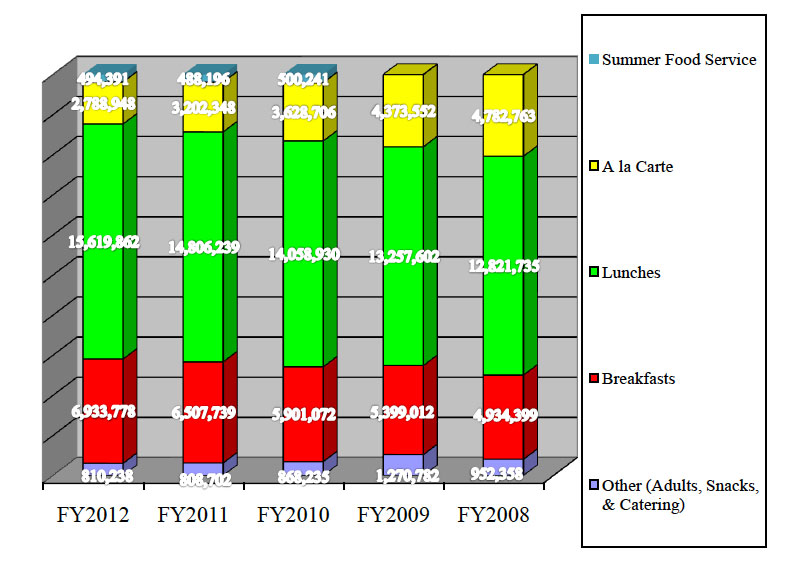

On average, approximately 148,000 meals are served daily to students in The School District of Palm Beach County by the School Food Service (SFS) Department. Much like other public and nonprofit private schools and residential child care institutions, The School District of Palm Beach County operates multiple federally assisted Child Nutrition Programs. In Palm Beach County, all students have the opportunity to participate in the National School Lunch Program (NSLP) and the School Breakfast Program (SBP). In addition, many schools offer an Afterschool Snack Program (ASSP) and a Summer Food Service Program (SFSP).
All four of the Child Nutrition Programs are governed by the United States Department of Agriculture (USDA) at the federal level. During the 2011 legislative session and with the approval from the USDA, Florida’s food and nutrition programs were transferred from Department of Education (DOE) to the Florida Department of Agriculture and Consumer Services (FDACS) - Division of Food, Nutrition and Wellness. Adam Putnam leads FDACS, as he was elected to serve as Florida’s Commissioner of Agriculture in 2012.
Children may qualify for free and reduced price meals. This qualification is based on household income. Children from families with incomes at or below 130% of the poverty level are eligible for free meals. Those with incomes between 130-185% of the poverty level are eligible for reduced-price meals. All students across the nation who qualify for reduced-price meals are charge 40 cents for lunch. In Palm Beach County, we continue to see the number of students qualifying for free and reduced price meals increase. Simultaneously, we have seen participation in all of our Child Nutrition Programs increase as well.

In addition to the transfer of Child Nutrition Programs at the state level, USDA released new nutrition standards in January 2012 for implementation in July 2012. The changes outlined in Federal Register 7 CFR Parts 210 and 220 - Nutrition Standards in the National School Lunch and School Breakfast Programs; Final Rule came at a critical time in our society when nearly 1 in 3 children are considered at risk for preventable health conditions.
The legislation focused on comprehensive changes to the school nutrition environment which had not been updated for over 15 years. The new standards for Child Nutrition Programs will aim to increase the availability of fruit and vegetables, whole grain bread products and fat-free and low-fat dairy products. In addition, meals will provide lower amounts of saturated fat and sodium levels while eliminating trans fat from student meals.
Even under the new legislation, the SFS Department will continue to utilize Offer versus Serve (OVS). OVS allows students to decline some of the food items “components” offered in a school breakfast or school lunch meals. The goal of OVS is to reduce food waste and permit students to select the foods they prefer as part of a complete meal.
The following are the meal component guidelines for the 2011-2012 school year:
- default_titleFor breakfast students must be offered 4 components: 1 Meat/Meat Alternate, 1 Bread/Grain, 1 Fruit/Vegetable, and 1 Fluid Milk.
- default_titleFor lunch students must be offered 5 components: 1 Meat/Meat Alternate, 1 Bread/Grain, 2 Fruit/Vegetable, and 1 Fluid Milk.
- Show More
For a complete meal a student must select at least 3 components for both breakfast and lunch.
Moving into the 2012-2013 school year, fruits and vegetables will be separate components and students will have to select either a fruit or vegetable component to ensure a complete meal is selected.
During the 2011-2012 school year, the School Food Service Department served over 15.6 million lunches and 6.9 million breakfasts.
Total Number of Meals Served by Category

In FY 2012, more than 31.8 million children each day received their lunch through the National School Lunch Program. Since its inception, more than 224 billion lunches have been served!
